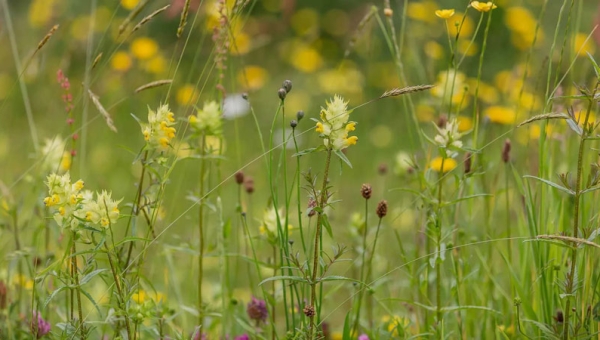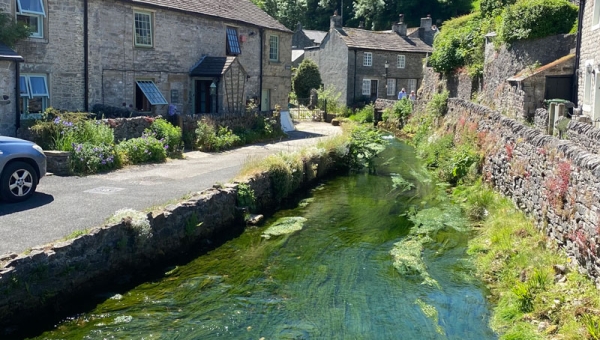
The Unsung Hero of Wildflower Meadows
When we think of wildflower meadows in the UK, vibrant displays of poppies, daisies, and buttercups often come to mind. However, there's one small but mighty plant that plays a pivotal role in creating these rich tapestries of colour; the Yellow Rattle (Rhinanthus minor). Often overlooked due to its understated appearance. This humble plant is actually a cornerstone in the ecological balance of meadows, earning it the nickname "meadow maker."
What is Yellow Rattle?
Yellow Rattle sometimes known as hay rattle is an annual plant that can be found across the UK, particularly in ancient meadows and grasslands. It gets its name from the yellow flowers it produces and the rattling sound made by the seeds in their pods as they mature in late summer. But what makes Yellow Rattle truly fascinating is its parasitic or hemi parasitic nature.
A Parasitic Plant with a Purpose
Unlike most plants, Yellow Rattle is a hemiparasite, meaning it derives some of its nutrients from other plants. It does this by attaching its roots to the roots of nearby plants, mainly grasses, siphoning off water and nutrients. While this might sound detrimental to the meadow, it’s a key factor in maintaining the diversity of wildflowers.
Keeping Grasses in Check
Grasses are often highly competitive and without intervention, they can easily dominate a meadow, crowding out more delicate wildflowers. Yellow Rattle, by weakening these grasses, creates space and opportunities for a wider range of species to thrive. This reduction in grass vigour leads to a more open sward, allowing wildflower seeds to germinate and grow. The result is a meadow rich in diversity, both in terms of species and structure.
Promoting Biodiversity
The introduction of Yellow Rattle to a meadow can lead to an explosion of biodiversity. With grasses no longer monopolizing the space, wildflowers such as orchids, corn cockles, vetch and others can flourish. This, in turn, attracts a variety of pollinators, including bees, butterflies, and moths; this trait has been recognised by the RHS as Yellow Rattle has been included in its plants for pollinators list for increasing biodiversity. An increase in insect life then supports a wider range of birds and small mammals. In turn, this creates a thriving ecosystem that benefits from the presence of Yellow Rattle.
The Conservation and Management of Meadows
For conservationists and land managers, Yellow Rattle is a vital tool in meadow restoration projects. By sowing Yellow Rattle seeds, they can reduce the dominance of grasses and encourage the growth of a more diverse range of wildflowers. This process we have found often takes a few years to fully establish due to the extensive ground coverage often enjoyed by grasses; but the long-term benefits are significant, leading to resilient and biodiverse habitats.
A Natural Solution to Declining Meadows
The UK's wildflower meadows have declined dramatically over the past century, with over 97% of them lost due to changes in agricultural practices and land use. The reintroduction of Yellow Rattle into these landscapes is a natural and effective way to restore these precious ecosystems. It’s a small plant with a big impact, reminding us of the delicate balance required to maintain biodiversity in our natural landscapes.
Conclusion: Celebrating the Meadow Maker
Yellow Rattle might not be the most eye-catching plant in a wildflower meadow, but its role is crucial. By curbing the dominance of grasses, it allows a greater variety of plants to thrive, enhancing the beauty and ecological value of the meadow. As conservation efforts continue across the UK, Yellow Rattle will undoubtedly remain a key player in the revival of these vital habitats.
So, next time you wander through a wildflower meadow, take a moment to appreciate the understated heroism of Yellow Rattle; the plant that makes the meadow bloom.
Charisma Making a Comeback: The Rise of the Pine Marten and the Power of Perception in Conservation
When we think of charismatic animals, we often imagine creatures with show-stopping qualities—maybe they’re massive, rare, or downright beautiful. Our fascination is drawn to these defining features, which is why certain animals, especially large predators or exotic species, dominate our imagination and our conservation efforts. The graph below, created by Celine Albert for the National Institute for Health, highlights this trend by showing the animals most commonly viewed as charismatic. Not surprisingly, you’ll notice that small European mammals don’t make much of a showing on the list….
One animal notably absent from this "charismatic" list is the pine marten (Martes martes). Though perhaps not conventionally charismatic, the pine marten is an animal with ample personality and a vibrant presence in the ecosystem. Unlike the stereotypical "charismatic" animals, the pine marten is small, agile, and understated, but its character and ecological importance are massive. In fact, if we look beyond the "big and beautiful" narrative, we find that these lesser-celebrated animals like the pine marten play an equally crucial role in their habitats.
Another interesting aspect of Albert’s findings is how closely the list of "charismatic" animals correlates with public conservation efforts and reintroduction programs. Take, for instance, the Grey Wolf. Although it’s listed as a species of "Least Concern" on the IUCN Red List, with stable and growing populations worldwide, it has benefited from some of the most significant reintroduction efforts in modern conservation. Evans et al. highlighted this phenomenon in their paper, Reintroduction Biology and the IUCN Red List: The Dominance of Species of Least Concern in the Peer-Reviewed Literature, pointing out that our conservation efforts often prioritise species that we find relatable or iconic, even if they arenot at immediate or even a slight risk of extinction in this example. This trend underscores the influence that charisma has on conservation—but it also suggests an opportunity for a shift in perspective, one where animals like the pine marten can take the spotlight.
The Missing Mustelid
The pine marten is a striking creature, not because of sheer size or rarity, but because of its unique charm. With its slender body, bushy tail, and pale yellow "bib" adorning its throat, it’s an animal that’s easy to recognise once you know what to look for. Adult pine martens typically measure around 50 to 70 centimetres in length, with males slightly larger than females. Unlike larger predators that roam open fields, pine martens are primarily nocturnal and thrive in dense woodlands. Here, they find mature trees for shelter and ample prey to hunt, relying on the forest's structure to support their arboreal lifestyle.
Though they’re somewhat smaller than most iconic predators, pine martens play a crucial role in the health of their ecosystem. As opportunistic carnivores, they act as a control within the food web, balancing populations of prey species and, indirectly, contributing to the recovery of species like the red squirrel. Interestingly, pine martens hunt grey squirrels more frequently than red squirrels. This difference comes down to behaviour and biology as grey squirrels, which are heavier and less adapted for speed, make easier targets for pine martens. Red squirrels, in contrast, are lighter and quicker, able to escape these agile predators. This predation pattern has allowed red squirrel populations to rebound in areas with a strong pine marten presence.
The pine marten’s impact doesn’t stop with squirrel dynamics and being a saviour of our lead flashing; their predation on small mammals, birds, and insects prevents overpopulation and promotes a balanced ecosystem. In this way, they help keep the forest healthy, ensuring no one species can dominate and cause damage to the trees or the broader biodiversity. Their ability to consume a variety of foods, including fruit, further underscores their role as ecological stabilisers, keeping both flora and fauna in check and promoting forest resilience.
Conservation Efforts and the Remarkable Comeback of the Pine Marten
Like many predators, pine martens were targeted throughout the 18th century, when their numbers dwindled dramatically due to hunting and trapping. Viewed as threats to game populations, they were systematically removed by gamekeepers, who sold their pelts at high prices. The relentless hunting pushed the pine marten population in the UK close to extinction, with their last stronghold in the remote forests of Scotland. By 1924, it was estimated that only around 50 breeding pairs remained in the UK.
However, with the rise of conservation awareness in the late 20th century, this began to change. Legal protections, along with public awareness campaigns, brought attention to the importance of preserving native species like the pine marten. Efforts to reintroduce and protect these animals took root, particularly in areas where suitable forest habitats could support their populations. In recent years, reintroduction programs have even expanded to parts of southern England, allowing the pine marten to reclaim territories it had been forcedto abandon centuries ago.
Today, the population has rebounded to an estimated 1,500 to 2,000 breeding pairs in the UK—a stunning recovery for a species once on the brink. This resurgence is more than a conservation success story; it’s a reminder that, with enough dedication and public support, species that lack initial "charisma" can become emblematic of a balanced, healthy ecosystem. The pine marten’s comeback reflects a shift toward valuing animals for their ecological roles, not just their aesthetic appeal.
A New Kind of Charisma in Conservation
The story of the pine marten is an inspiring example of how our understanding of charisma in wildlife is evolving. Charisma isn’t just the beauty, grandeur or impressive statistics of a species—it’s also about the impact, character, and significance of a species within its habitat. By broadening our concept of what makes an animal "charismatic," we can elevate the status of species like the pine marten and foster conservation efforts that support a wider variety of animals, including those that don’t typically make the headlines.
As we move forward, we at Willow and Wilde believe that we should continue to redefine charisma in a way that values all creatures for their unique contributions. After all, the resilience and subtle charm of the pine marten show us that sometimes, the most unassuming animals have the most profound impacts on their ecosystems. And as we’ve seen right here in the UK, when given a chance, they’re more than capable of making an impressive comeback.
References:
Albert C, Luque GM, Courchamp F (2018) The twenty most charismatic species. PLoS ONE 13(7): e0199149. https://doi.org/10.1371/journal.pone.0199149

Unit 9, Honeycrest Industrial Estate,
Lodge Road, Staplehurst,
Kent TN12 0RX

